Guolong Su
Noise-Aware Training of Layout-Aware Language Models
Mar 30, 2024Abstract:A visually rich document (VRD) utilizes visual features along with linguistic cues to disseminate information. Training a custom extractor that identifies named entities from a document requires a large number of instances of the target document type annotated at textual and visual modalities. This is an expensive bottleneck in enterprise scenarios, where we want to train custom extractors for thousands of different document types in a scalable way. Pre-training an extractor model on unlabeled instances of the target document type, followed by a fine-tuning step on human-labeled instances does not work in these scenarios, as it surpasses the maximum allowable training time allocated for the extractor. We address this scenario by proposing a Noise-Aware Training method or NAT in this paper. Instead of acquiring expensive human-labeled documents, NAT utilizes weakly labeled documents to train an extractor in a scalable way. To avoid degradation in the model's quality due to noisy, weakly labeled samples, NAT estimates the confidence of each training sample and incorporates it as uncertainty measure during training. We train multiple state-of-the-art extractor models using NAT. Experiments on a number of publicly available and in-house datasets show that NAT-trained models are not only robust in performance -- it outperforms a transfer-learning baseline by up to 6% in terms of macro-F1 score, but it is also more label-efficient -- it reduces the amount of human-effort required to obtain comparable performance by up to 73%.
Gemini 1.5: Unlocking multimodal understanding across millions of tokens of context
Mar 08, 2024Abstract:In this report, we present the latest model of the Gemini family, Gemini 1.5 Pro, a highly compute-efficient multimodal mixture-of-experts model capable of recalling and reasoning over fine-grained information from millions of tokens of context, including multiple long documents and hours of video and audio. Gemini 1.5 Pro achieves near-perfect recall on long-context retrieval tasks across modalities, improves the state-of-the-art in long-document QA, long-video QA and long-context ASR, and matches or surpasses Gemini 1.0 Ultra's state-of-the-art performance across a broad set of benchmarks. Studying the limits of Gemini 1.5 Pro's long-context ability, we find continued improvement in next-token prediction and near-perfect retrieval (>99%) up to at least 10M tokens, a generational leap over existing models such as Claude 2.1 (200k) and GPT-4 Turbo (128k). Finally, we highlight surprising new capabilities of large language models at the frontier; when given a grammar manual for Kalamang, a language with fewer than 200 speakers worldwide, the model learns to translate English to Kalamang at a similar level to a person who learned from the same content.
Gemini: A Family of Highly Capable Multimodal Models
Dec 19, 2023Abstract:This report introduces a new family of multimodal models, Gemini, that exhibit remarkable capabilities across image, audio, video, and text understanding. The Gemini family consists of Ultra, Pro, and Nano sizes, suitable for applications ranging from complex reasoning tasks to on-device memory-constrained use-cases. Evaluation on a broad range of benchmarks shows that our most-capable Gemini Ultra model advances the state of the art in 30 of 32 of these benchmarks - notably being the first model to achieve human-expert performance on the well-studied exam benchmark MMLU, and improving the state of the art in every one of the 20 multimodal benchmarks we examined. We believe that the new capabilities of Gemini models in cross-modal reasoning and language understanding will enable a wide variety of use cases and we discuss our approach toward deploying them responsibly to users.
LMDX: Language Model-based Document Information Extraction and Localization
Sep 19, 2023Abstract:Large Language Models (LLM) have revolutionized Natural Language Processing (NLP), improving state-of-the-art on many existing tasks and exhibiting emergent capabilities. However, LLMs have not yet been successfully applied on semi-structured document information extraction, which is at the core of many document processing workflows and consists of extracting key entities from a visually rich document (VRD) given a predefined target schema. The main obstacles to LLM adoption in that task have been the absence of layout encoding within LLMs, critical for a high quality extraction, and the lack of a grounding mechanism ensuring the answer is not hallucinated. In this paper, we introduce Language Model-based Document Information Extraction and Localization (LMDX), a methodology to adapt arbitrary LLMs for document information extraction. LMDX can do extraction of singular, repeated, and hierarchical entities, both with and without training data, while providing grounding guarantees and localizing the entities within the document. In particular, we apply LMDX to the PaLM 2-S LLM and evaluate it on VRDU and CORD benchmarks, setting a new state-of-the-art and showing how LMDX enables the creation of high quality, data-efficient parsers.
FormNetV2: Multimodal Graph Contrastive Learning for Form Document Information Extraction
May 04, 2023
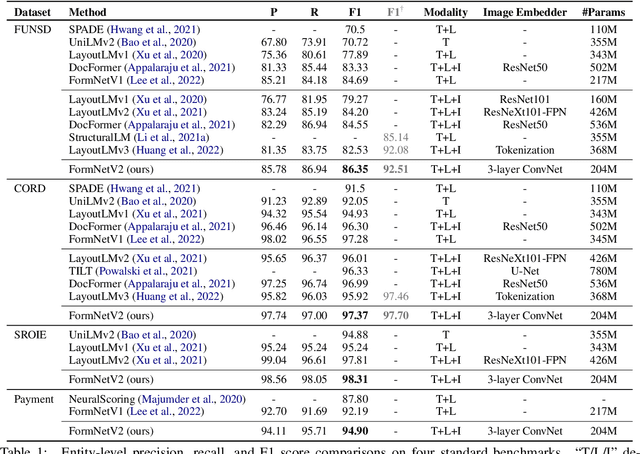
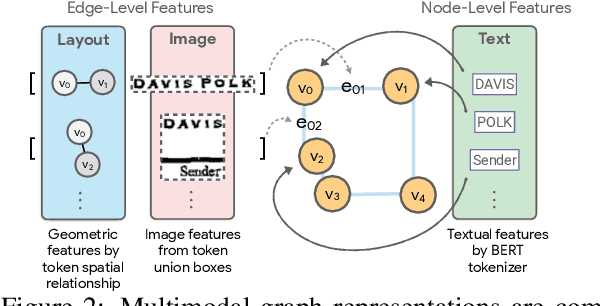

Abstract:The recent advent of self-supervised pre-training techniques has led to a surge in the use of multimodal learning in form document understanding. However, existing approaches that extend the mask language modeling to other modalities require careful multi-task tuning, complex reconstruction target designs, or additional pre-training data. In FormNetV2, we introduce a centralized multimodal graph contrastive learning strategy to unify self-supervised pre-training for all modalities in one loss. The graph contrastive objective maximizes the agreement of multimodal representations, providing a natural interplay for all modalities without special customization. In addition, we extract image features within the bounding box that joins a pair of tokens connected by a graph edge, capturing more targeted visual cues without loading a sophisticated and separately pre-trained image embedder. FormNetV2 establishes new state-of-the-art performance on FUNSD, CORD, SROIE and Payment benchmarks with a more compact model size.
QueryForm: A Simple Zero-shot Form Entity Query Framework
Nov 14, 2022Abstract:Zero-shot transfer learning for document understanding is a crucial yet under-investigated scenario to help reduce the high cost involved in annotating document entities. We present a novel query-based framework, QueryForm, that extracts entity values from form-like documents in a zero-shot fashion. QueryForm contains a dual prompting mechanism that composes both the document schema and a specific entity type into a query, which is used to prompt a Transformer model to perform a single entity extraction task. Furthermore, we propose to leverage large-scale query-entity pairs generated from form-like webpages with weak HTML annotations to pre-train QueryForm. By unifying pre-training and fine-tuning into the same query-based framework, QueryForm enables models to learn from structured documents containing various entities and layouts, leading to better generalization to target document types without the need for target-specific training data. QueryForm sets new state-of-the-art average F1 score on both the XFUND (+4.6%~10.1%) and the Payment (+3.2%~9.5%) zero-shot benchmark, with a smaller model size and no additional image input.
DualPrompt: Complementary Prompting for Rehearsal-free Continual Learning
Apr 10, 2022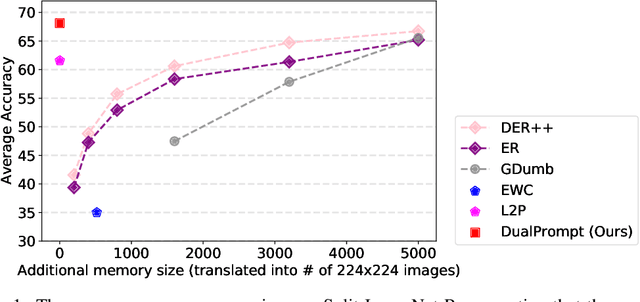
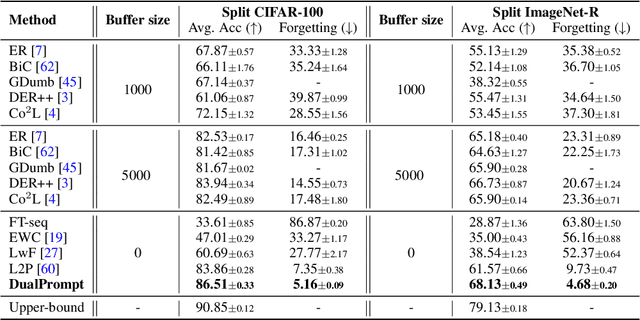

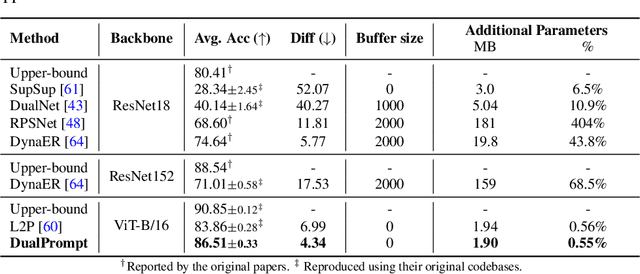
Abstract:Continual learning aims to enable a single model to learn a sequence of tasks without catastrophic forgetting. Top-performing methods usually require a rehearsal buffer to store past pristine examples for experience replay, which, however, limits their practical value due to privacy and memory constraints. In this work, we present a simple yet effective framework, DualPrompt, which learns a tiny set of parameters, called prompts, to properly instruct a pre-trained model to learn tasks arriving sequentially without buffering past examples. DualPrompt presents a novel approach to attach complementary prompts to the pre-trained backbone, and then formulates the objective as learning task-invariant and task-specific "instructions". With extensive experimental validation, DualPrompt consistently sets state-of-the-art performance under the challenging class-incremental setting. In particular, DualPrompt outperforms recent advanced continual learning methods with relatively large buffer sizes. We also introduce a more challenging benchmark, Split ImageNet-R, to help generalize rehearsal-free continual learning research. Source code is available at https://github.com/google-research/l2p.
FormNet: Structural Encoding beyond Sequential Modeling in Form Document Information Extraction
Mar 24, 2022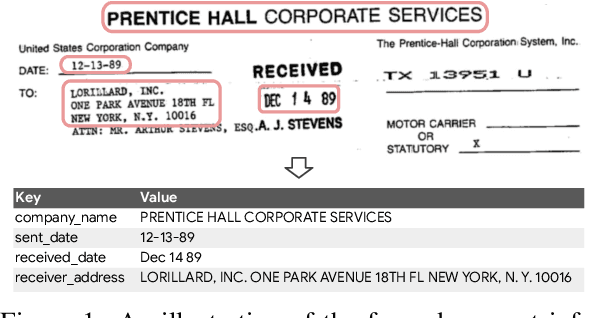
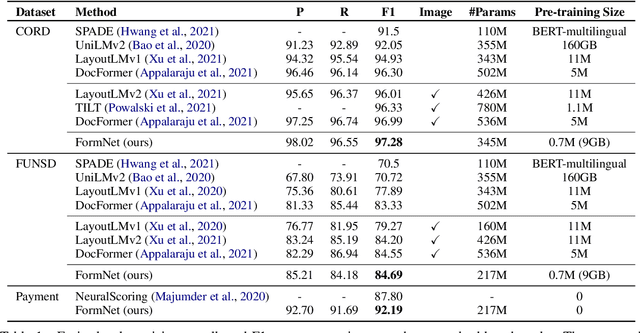

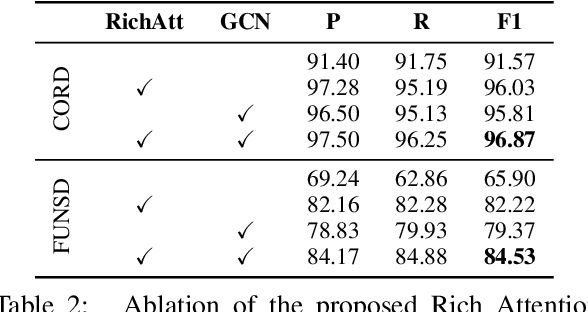
Abstract:Sequence modeling has demonstrated state-of-the-art performance on natural language and document understanding tasks. However, it is challenging to correctly serialize tokens in form-like documents in practice due to their variety of layout patterns. We propose FormNet, a structure-aware sequence model to mitigate the suboptimal serialization of forms. First, we design Rich Attention that leverages the spatial relationship between tokens in a form for more precise attention score calculation. Second, we construct Super-Tokens for each word by embedding representations from their neighboring tokens through graph convolutions. FormNet therefore explicitly recovers local syntactic information that may have been lost during serialization. In experiments, FormNet outperforms existing methods with a more compact model size and less pre-training data, establishing new state-of-the-art performance on CORD, FUNSD and Payment benchmarks.
Learning to Prompt for Continual Learning
Dec 16, 2021
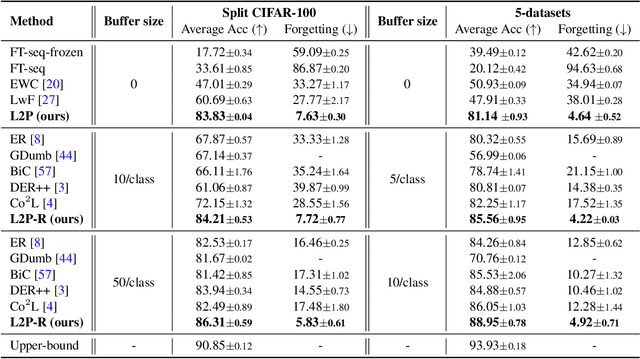
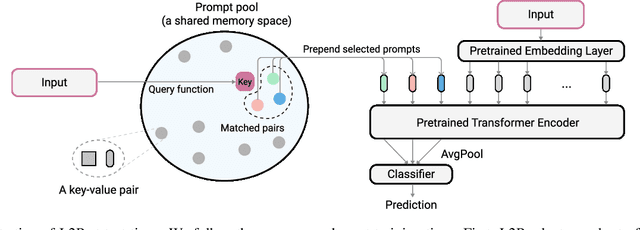
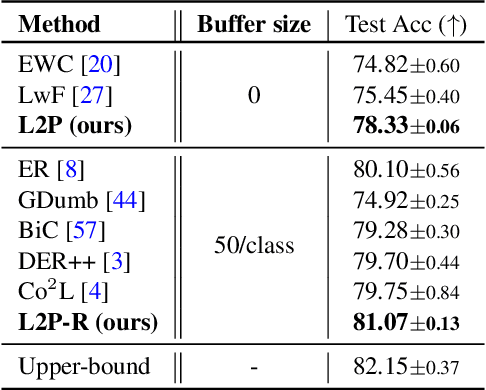
Abstract:The mainstream paradigm behind continual learning has been to adapt the model parameters to non-stationary data distributions, where catastrophic forgetting is the central challenge. Typical methods rely on a rehearsal buffer or known task identity at test time to retrieve learned knowledge and address forgetting, while this work presents a new paradigm for continual learning that aims to train a more succinct memory system without accessing task identity at test time. Our method learns to dynamically prompt (L2P) a pre-trained model to learn tasks sequentially under different task transitions. In our proposed framework, prompts are small learnable parameters, which are maintained in a memory space. The objective is to optimize prompts to instruct the model prediction and explicitly manage task-invariant and task-specific knowledge while maintaining model plasticity. We conduct comprehensive experiments under popular image classification benchmarks with different challenging continual learning settings, where L2P consistently outperforms prior state-of-the-art methods. Surprisingly, L2P achieves competitive results against rehearsal-based methods even without a rehearsal buffer and is directly applicable to challenging task-agnostic continual learning. Source code is available at https://github.com/google-research/l2p.
Interpretable Two-level Boolean Rule Learning for Classification
Jun 18, 2016
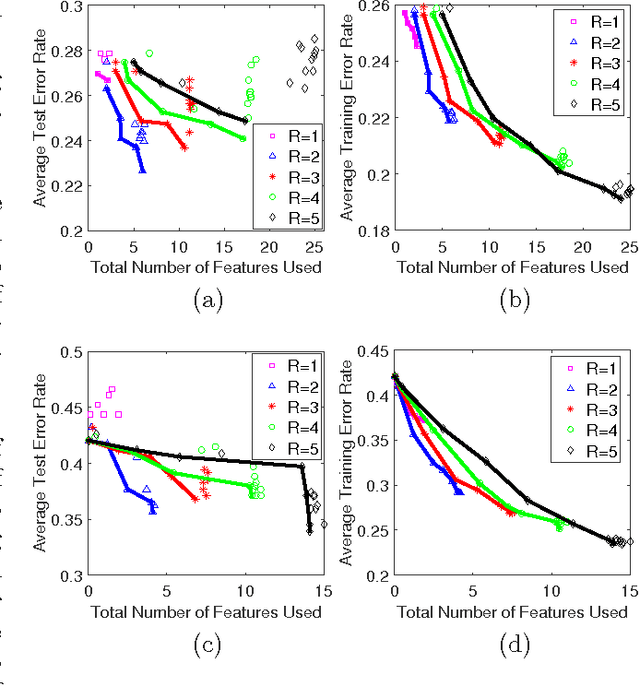

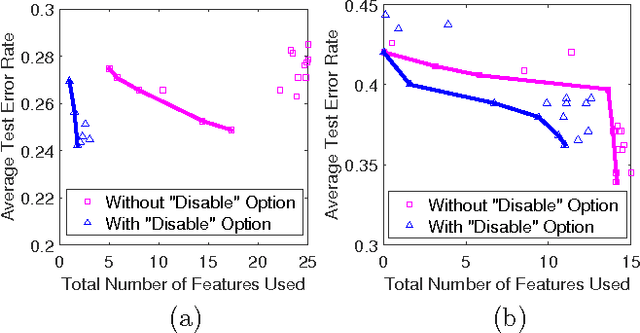
Abstract:As a contribution to interpretable machine learning research, we develop a novel optimization framework for learning accurate and sparse two-level Boolean rules. We consider rules in both conjunctive normal form (AND-of-ORs) and disjunctive normal form (OR-of-ANDs). A principled objective function is proposed to trade classification accuracy and interpretability, where we use Hamming loss to characterize accuracy and sparsity to characterize interpretability. We propose efficient procedures to optimize these objectives based on linear programming (LP) relaxation, block coordinate descent, and alternating minimization. Experiments show that our new algorithms provide very good tradeoffs between accuracy and interpretability.
 Add to Chrome
Add to Chrome Add to Firefox
Add to Firefox Add to Edge
Add to Edge